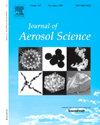Prediction of enthalpy of vaporization for particulate matter through molecular dynamics using OPLS force field
IF 3.9
3区 环境科学与生态学
Q2 ENGINEERING, CHEMICAL
引用次数: 0
Abstract
Chemical pollutant molecules dispersed in the atmosphere in the form of particulate matter are harmful to humans. Accurate data sets on the volatility of particulate matter components are required to address the ongoing issues of air pollution, as volatility determines the distribution of particulate components between gas and particle phases. Herein, we estimate the volatility for representative components of particulate matter by calculating the enthalpy of vaporization using molecular dynamics simulations. Compared with conventional static prediction methods such as Hansen solubility parameter and conductor-like screening model methods, the molecular dynamics method proves to effectively and accurately predict enthalpies of vaporization for a wide range of particulate matter components without additional parameter optimization. Using the molecular dynamics approach, we calculate enthalpies of vaporization for 71 representative organic species that could be primary particulate matter sources. The predicted enthalpy of vaporization values can be used as a fundamental data set for future air quality modeling and scientific understanding of the formation of particulate matter. Given the limitations in experimentally characterizing the volatility of various components in particulate matter, we envisage that our dynamical method based on the evaluation of intermolecular interactions can also be used to study the dynamics associated with the formation of particulate matter in addition to providing thermodynamic data.

利用ops力场的分子动力学方法预测颗粒物质的汽化焓
化学污染物分子以颗粒物的形式分散在大气中,对人体有害。由于挥发性决定了气体和颗粒相之间颗粒成分的分布,因此需要关于颗粒物成分挥发性的准确数据集来解决持续存在的空气污染问题。本文通过分子动力学模拟计算汽化焓来估计颗粒物质中代表性组分的挥发性。与传统的静态预测方法(如Hansen溶解度参数和类导体筛选模型方法)相比,分子动力学方法可以有效准确地预测大范围颗粒物组分的汽化焓,而无需额外的参数优化。利用分子动力学方法,我们计算了71种有代表性的有机物质的蒸发焓,这些有机物质可能是主要的颗粒物来源。预测的蒸发焓值可以作为未来空气质量建模和对颗粒物形成的科学理解的基础数据集。鉴于实验表征颗粒物质中各种组分挥发性的局限性,我们设想基于分子间相互作用评估的动力学方法除了提供热力学数据外,还可以用于研究与颗粒物质形成相关的动力学。
本文章由计算机程序翻译,如有差异,请以英文原文为准。
求助全文
约1分钟内获得全文
求助全文
来源期刊

Journal of Aerosol Science
环境科学-工程:化工
CiteScore
8.80
自引率
8.90%
发文量
127
审稿时长
35 days
期刊介绍:
Founded in 1970, the Journal of Aerosol Science considers itself the prime vehicle for the publication of original work as well as reviews related to fundamental and applied aerosol research, as well as aerosol instrumentation. Its content is directed at scientists working in engineering disciplines, as well as physics, chemistry, and environmental sciences.
The editors welcome submissions of papers describing recent experimental, numerical, and theoretical research related to the following topics:
1. Fundamental Aerosol Science.
2. Applied Aerosol Science.
3. Instrumentation & Measurement Methods.
 求助内容:
求助内容: 应助结果提醒方式:
应助结果提醒方式:


